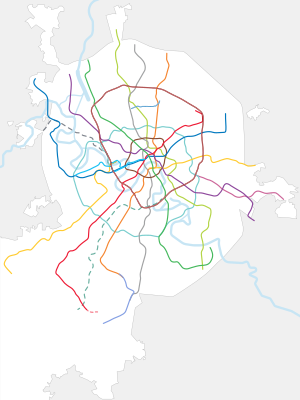| Moscow Metro | |||
|---|---|---|---|
 | |||
| Overview | |||
| Native name | Московский метрополитен | ||
| Owner | Government of Moscow | ||
| Area served | Moscow | ||
| Locale | Federal city of Moscow and cities of Kotelniki, Krasnogorsk, Lyubertsy, Reutov in Moscow Oblast, Russia | ||
| Transit type | Rapid transit | ||
| Number of lines | 19 (including the Moscow Monorail and the Moscow Central Circle)[1] | ||
| Number of stations | 297 | ||
| Daily ridership | (average) 7.5 million (highest, 26 Dec 2014) 9.715 million [1] | ||
| Annual ridership | 2.5 billion (2018)[1] | ||
| Chief executive | Viktor Kozlovsky | ||
| Website | mosmetro | ||
| Operation | |||
| Began operation | 15 May 1935 | ||
| Operator(s) | Moskovsky Metropoliten | ||
| Headway | Peak hours: 1.3 - 1.7 mins Off-peak: 2.5 - 10 minutes | ||
| Technical | |||
| System length | 519.4 km (322.7 mi)[1] | ||
| Track gauge | 1,520 mm (4 ft 11+27⁄32 in) | ||
| Electrification | 825 Volt DC third rail, 3 kV DC overhead line | ||
| Average speed | 39.54 km/h (24.57 mph)[1] | ||
| Top speed | 80 km/h (50 mph)[1] | ||
| |||
The Moscow Metro[a] is a metro system serving the Russian capital of Moscow as well as the neighbouring cities of Krasnogorsk, Reutov, Lyubertsy and Kotelniki in Moscow Oblast. Opened in 1935 with one 11-kilometre (6.8 mi) line and 13 stations, it was the first underground railway system in the Soviet Union.
As of September 2024[update], the Moscow Metro had 297 stations and 519.4 km (322.7 mi) of route length, excluding light rail Monorail,[1] making it the 8th-longest in the world and the longest outside China. It is also the only system with three circle lines.[2] The system is mostly underground, with the deepest section 73 m (240 ft) underground at the Park Pobedy station, one of the world's deepest underground stations. It is the busiest metro system in Europe, the busiest in the world outside Asia, and is considered a tourist attraction in itself, thanks to its lavish interior decoration.[3]
The Moscow Metro is a world leader in the frequency of train traffic, as intervals during peak hours often do not exceed 90 seconds.[4] In February 2023, Moscow was the first in the world to reduce the intervals of metro trains to 80 seconds, but in practice trains are not likely to exceed the 90 seconds interval.[5]
- ^ a b c d e f g Метрополитен в цифрах [Metropolitan in figures] (in Russian). Moscow Metro. Archived from the original on 26 December 2018. Retrieved 17 March 2018.
- ^ "Как выглядят новые станции Большой кольцевой линии метро". MSK News. March 2023.
- ^ "The best places to visit in Moscow". Expatica.
- ^ "Москва первой в мире снизила интервал движения поездов метро до 90 секунд". Moscow 24.
- ^ "Москва побила рекорд по интервалу движения поездов метро". NEWS.ru.
Cite error: There are <ref group=lower-alpha> tags or {{efn}} templates on this page, but the references will not show without a {{reflist|group=lower-alpha}} template or {{notelist}} template (see the help page).













